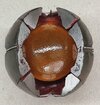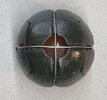pzgr40
Well-Known Member
Cutaway model of a French tear gas hand grenade suffocante Bertrand model 1915.
This hand grenade consisted of six square pig iron cast segments with protruding points on the inside at the corners of the segments, six of together form a round ball of 60 mm diameter. A thin glass sphere filled with 25 grams of chloroacetone (C3H5ClO) was placed in the grenade body after which the segments were fixated by means of thin steel wires. The intention was that when the grenade was thrown it would deform when hitting a hard object, causing the glass sphere to break as a result of one or more of the points on the inside were pressed through the glass, after which the chloroacetone was released.
The weight of the grenade is 200 grams
A remarkable thing about this grenade is that it does not use expensive and production-intensive parts such as a fuze and is therefore cheap to produce.
The grenade was however particularly unpopular with the troops, which is evident from the fact that after the First World War they were often found in large numbers in the rear land or at the beginning of communication trenches. The great risk of this grenade was that it often broke when it was carried in the backpack or uniform, which resulted in a uniform soaked in tear gas, temporarily incapacitating the soldier. That is why French soldiers dumped these hand grenades at the first opportunity.
Also, the amount of tear gas in the grenade was too small to be really effective. Later in the First World War, the tear gas hand grenade Bertrand model 1916 was designed, the same design with a 120 mm diameter, but also unpopular for the same reason.
Regards, DJH
This hand grenade consisted of six square pig iron cast segments with protruding points on the inside at the corners of the segments, six of together form a round ball of 60 mm diameter. A thin glass sphere filled with 25 grams of chloroacetone (C3H5ClO) was placed in the grenade body after which the segments were fixated by means of thin steel wires. The intention was that when the grenade was thrown it would deform when hitting a hard object, causing the glass sphere to break as a result of one or more of the points on the inside were pressed through the glass, after which the chloroacetone was released.
The weight of the grenade is 200 grams
A remarkable thing about this grenade is that it does not use expensive and production-intensive parts such as a fuze and is therefore cheap to produce.
The grenade was however particularly unpopular with the troops, which is evident from the fact that after the First World War they were often found in large numbers in the rear land or at the beginning of communication trenches. The great risk of this grenade was that it often broke when it was carried in the backpack or uniform, which resulted in a uniform soaked in tear gas, temporarily incapacitating the soldier. That is why French soldiers dumped these hand grenades at the first opportunity.
Also, the amount of tear gas in the grenade was too small to be really effective. Later in the First World War, the tear gas hand grenade Bertrand model 1916 was designed, the same design with a 120 mm diameter, but also unpopular for the same reason.
Regards, DJH


